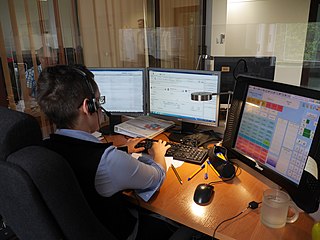An automated call distribution system, commonly known as automatic call distributor (ACD), is a telephony device that answers and distributes incoming calls to a specific group of terminals or agents within an organization. ACDs direct calls based on parameters that may include the caller's telephone number, the number they dialed, the time of day or a response to an automated voice prompt. Advanced ACD systems may use digital technologies such as Computer telephony integration (CTI), computer-supported telecommunications applications (CSTA) or IVR as input to determine the route to a person or voice announcement that will serve the caller. Experts claim that "the invention of ACD technology made the concept of a call centre possible."

9-1-1, usually written 911, is an emergency telephone number for Argentina, Canada, Dominican Republic, Jordan, Mexico, Palau, Panama, the Philippines, the United States, and Uruguay, as well as the North American Numbering Plan (NANP), one of eight N11 codes. Like other emergency numbers around the world, this number is intended for use in emergency circumstances only. Using it for any other purpose is a crime in most jurisdictions.
Caller identification is a telephone service, available in analog and digital telephone systems, including voice over IP (VoIP), that transmits a caller's telephone number to the called party's telephone equipment when the call is being set up. The caller ID service may include the transmission of a name associated with the calling telephone number, in a service called Calling Name Presentation (CNAM). The service was first defined in 1993 in International Telecommunication Union – Telecommunication Standardization Sector (ITU-T) Recommendation Q.731.3.

A voicemail system is a computer-based system that allows users and subscribers to exchange personal voice messages; to select and deliver voice information; and to process transactions relating to individuals, organizations, products, and services, using an ordinary phone. The term is also used more broadly to denote any system of conveying a stored telecommunications voice messages, including using an answering machine. Most cell phone services offer voicemail as a basic feature; many corporate private branch exchanges include versatile internal voice-messaging services, and *98 vertical service code subscription is available to most individual and small business landline subscribers.

A telephone call or telephone conversation, also known as a phone call or voice call, is a connection over a telephone network between the called party and the calling party. Telephone calls started in the late 19th century. As technology has improved, a majority of telephone calls are made over a cellular network through mobile phones or over the internet with Voice over IP. Telephone calls are typically used for real-time conversation between two or more parties, especially when the parties cannot meet in person.
A toll-free telephone number or freephone number is a telephone number that is billed for all arriving calls. For the calling party, a call to a toll-free number from a landline is free of charge. A toll-free number is identified by a dialing prefix similar to an area code. The specific service access varies by country.
Call forwarding, or call diversion, is a telephony feature of all telephone switching systems which redirects a telephone call to another destination, which may be, for example, a mobile or another telephone number where the desired called party is available. Call forwarding was invented by Ernest J. Bonanno. In North America, the forwarded line usually rings once to remind the customer using call forwarding that the call is being redirected. More consistently, the forwarded line indicates its condition by stutter dial tone. Call forwarding typically can redirect incoming calls to any other domestic telephone number, but the owner of the forwarded line must pay any toll charges for forwarded calls. Call forwarding is often enabled by dialing *72 followed by the telephone number to which calls should be forwarded. Once someone answers, call forwarding is in effect. If no one answers or the line is busy, the dialing sequence must be repeated to effect call forwarding. Call forwarding is disabled by dialing *73. This feature requires a subscription from the telephone company. Also available in some areas is Remote Access to call forwarding, which permit the control over call forwarding from telephones other than the subscriber's telephone. VOIP and cable telephone systems also allow call forwarding to be set up and directed via their web portals.
Phone fraud, or more generally communications fraud, is the use of telecommunications products or services with the intention of illegally acquiring money from, or failing to pay, a telecommunication company or its customers.
In telephony, an automated attendant allows callers to be automatically transferred to an extension without the intervention of an operator/receptionist. Many AAs will also offer a simple menu system. An auto attendant may also allow a caller to reach a live operator by dialing a number, usually "0". Typically the auto attendant is included in a business's phone system such as a PBX, but some services allow businesses to use an AA without such a system. Modern AA services can route calls to mobile phones, VoIP virtual phones, other AAs/IVRs, or other locations using traditional land-line phones or voice message machines.

A public-safety answering point (PSAP), sometimes called public-safety access point, is a call center where emergency/non-emergency calls initiated by any landline, mobile or Voice Over Internet Protocol ("VOIP") subscriber is terminated. It can also happen that when 112 is dialed in then a logic is implemented by mobile or network operators to route the call to the nearest police station. It is a call center in almost all the countries including Canada and the United States responsible for answering calls to an emergency telephone number for police, firefighting, and ambulance services. Trained telephone operators are also usually responsible for dispatching these emergency services. Most PSAPs are now capable of caller location for landline calls, and many can handle mobile phone locations as well, where the mobile phone company has a handset to location system. Some can also use voice broadcasting where outgoing voice mail can be sent to many phone numbers at once, in order to alert people to a local emergency such as a chemical spill.

A business telephone system is a multiline telephone system typically used in business environments, encompassing systems ranging in technology from the key telephone system (KTS) to the private branch exchange (PBX).
GSM services are a standard collection of applications and features available over the Global System for Mobile Communications (GSM) to mobile phone subscribers all over the world. The GSM standards are defined by the 3GPP collaboration and implemented in hardware and software by equipment manufacturers and mobile phone operators. The common standard makes it possible to use the same phones with different companies' services, or even roam into different countries. GSM is the world's most dominant mobile phone standard.
Direct inward dialing (DID), also called direct dial-in (DDI) in Europe and Oceania, is a telecommunication service offered by telephone companies to subscribers who operate a private branch exchange (PBX) system. The feature provides service for multiple telephone numbers over one or more analog or digital physical circuits to the PBX, and transmits the dialed telephone number to the PBX so that a PBX extension is directly accessible for an outside caller, possibly by-passing an auto-attendant.
In residential telephony, an extension telephone is an additional telephone wired to the same telephone line as another. In middle 20th century telephone jargon, the first telephone on a line was a "Main Station" and subsequent ones "Extensions" or even called as intercom. Such extension phones allow making or receiving calls in different rooms, for example in a home, but any incoming call would ring all extensions and any one extension being in use would cause the line to be busy for all users. Some telephones intended for use as extensions have built in intercom features; a key telephone system for a small business may offer two to five lines, lamps indicating lines already in use, the ability to place calls on 'hold' and an intercom on each of the multiple extensions.

Google Voice is a telephone service that provides a U.S. phone number to Google Account customers in the U.S. and Google Workspace customers in Canada, Denmark, France, the Netherlands, Portugal, Spain, Sweden, Switzerland, the United Kingdom and the contiguous United States. It is used for call forwarding and voicemail services, voice and text messaging, as well as U.S. and international calls. Calls are forwarded to the phone number that each user must configure in the account web portal. Users can answer and receive calls on any of the phones configured to ring in the web portal. While answering a call, the user can switch between the configured phones. Subscribers in the United States can make outgoing calls to domestic and international destinations. The service is configured and maintained by users in a web-based application, similar in style to Google's email service Gmail, or Android and iOS applications on smartphones or tablets.
Call management is the process of designing and implementing inbound telephone call parameters, which govern the routing of these calls through a network. The process is most prominently utilized by corporations and the call centre industry and has its highest effectiveness when call logging software tools are used. Calls are routed according to the set up of calling features within the given system such as Call queues, IVR menus, Hunt groups and Recorded announcements. Call features provide a customised experience for the caller and maximize the efficiency of inbound call handling. Call management parameters can specify how calls are distributed according to an operator's skill level in relation to a call, the time and/or date of a call, the location of the caller or through automatic routing processes.
A virtual number, also known as direct inward dialing (DID) or access numbers, is a telephone number without a directly associated telephone line. Usually, these numbers are programmed to forward incoming calls to one of the pre-set telephone numbers, chosen by the client: fixed, mobile or VoIP. A virtual number can work like a gateway between traditional calls (PSTN) and VoIP.
Operator Messaging is the term, similar to Text Messaging and Voice Messaging, applying to an answering service call center who focuses on one specific scripting style that has grown out of the alphanumeric pager history.
Line2 is a telecommunications company founded in San Francisco in 2008 by Peter Sisson. The company is best known for Line2 apps, which provides Wi-Fi support for mobile phones and multiple devices in lieu of using the service provider.
An automatic dialer is an electronic device or software that automatically dials telephone numbers. Once the call has been answered, the autodialer either plays a recorded message or connects the call to a live person.



